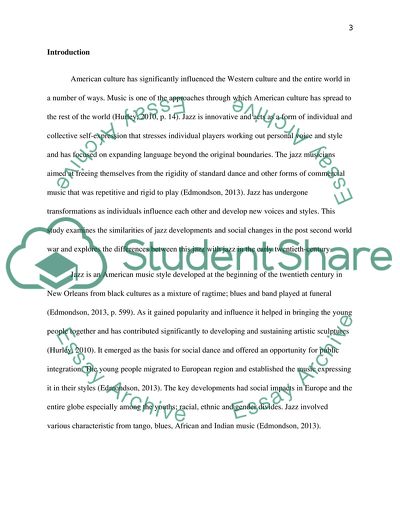Cite this document
(Jazz and Social Developments Essay Example | Topics and Well Written Essays - 1500 words, n.d.)
Jazz and Social Developments Essay Example | Topics and Well Written Essays - 1500 words. https://studentshare.org/music/1854736-did-developments-in-jazz-bewteen-the-end-of-world-war-2-and-the-early-1960s-parallel-social-developments-at-the-time-how-does-this-jazz-differ-from-jazz-at-the-beginning-of-the-twentieth-century
Jazz and Social Developments Essay Example | Topics and Well Written Essays - 1500 words. https://studentshare.org/music/1854736-did-developments-in-jazz-bewteen-the-end-of-world-war-2-and-the-early-1960s-parallel-social-developments-at-the-time-how-does-this-jazz-differ-from-jazz-at-the-beginning-of-the-twentieth-century
(Jazz and Social Developments Essay Example | Topics and Well Written Essays - 1500 Words)
Jazz and Social Developments Essay Example | Topics and Well Written Essays - 1500 Words. https://studentshare.org/music/1854736-did-developments-in-jazz-bewteen-the-end-of-world-war-2-and-the-early-1960s-parallel-social-developments-at-the-time-how-does-this-jazz-differ-from-jazz-at-the-beginning-of-the-twentieth-century.
Jazz and Social Developments Essay Example | Topics and Well Written Essays - 1500 Words. https://studentshare.org/music/1854736-did-developments-in-jazz-bewteen-the-end-of-world-war-2-and-the-early-1960s-parallel-social-developments-at-the-time-how-does-this-jazz-differ-from-jazz-at-the-beginning-of-the-twentieth-century.
“Jazz and Social Developments Essay Example | Topics and Well Written Essays - 1500 Words”. https://studentshare.org/music/1854736-did-developments-in-jazz-bewteen-the-end-of-world-war-2-and-the-early-1960s-parallel-social-developments-at-the-time-how-does-this-jazz-differ-from-jazz-at-the-beginning-of-the-twentieth-century.


